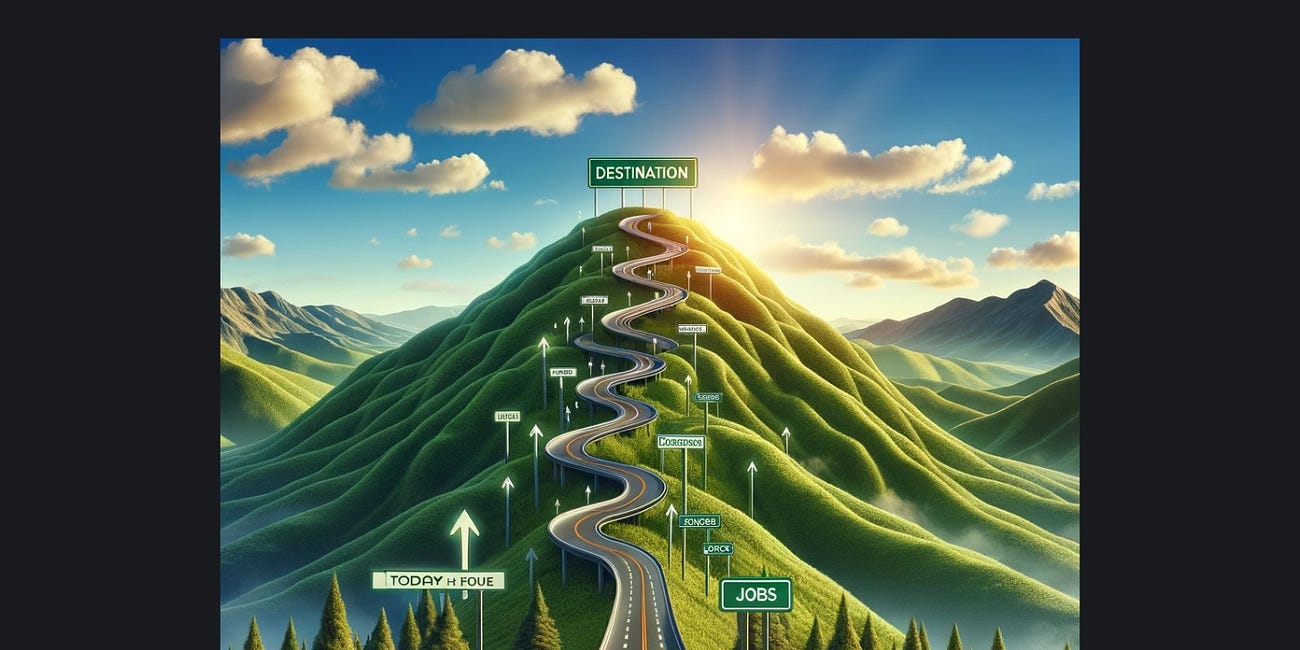Scenario Guide: Planning a Strategic Career Transformation
How to know what you want before allocating energy to get what you want
Knowing what you want in your career and life is essential to shaping your direction and daily decision-making. You will unlikely get what you want unless you know what you want. Most of us struggle with answering this question, and this indecision can keep us from reaching our full potential.
This scenario guide offers a process and ideas for planning a strategic career path or job transformation. This content is relevant to someone seeking deeper meaning and fulfillment in their work and rewards what is important to them. Most people want to become more intentional with their lives, and this guide will give you perspectives to consider.
The primary goal is to expand your perspective and creativity to know what you want before executing the tactical steps of getting what you want.
Given that each person is unique, as is their situation, you must determine which ideas below are most relevant to your transformation. The level of effort you spend on them is person-dependent.
This guide presents the following steps to shape a career transformation:
Adopt three career transformation mindsets.
Strategy 1: Know yourself to catalyze a transformation.
Learn how to change when everything is changing.
Strategy 2: Target your product to identify your path/job.
Strategy 3: Plan a roadmap to guide the direction toward your vision.
Specify requirements and named targets.
Document your decision process before making a career path or job transition.
Career Transformation Mindsets
While a framework provides the scaffolding for career strategy, mindsets shape our thinking about formulating and executing the strategy.
💡 You must practice at least three mindsets to know what you want so you can get what you want.
Strategist: You are a competitive strategist deciding where and how to compete.
Long-term vision, purpose
Aware of shifts, trends
Focus on what you can control
Power dynamics
Options & Leverage
Product Manager: You are the product manager of a portfolio of "expertise products" for sale in the talent marketplace.
Product-market fit
Credible, unique value proposition
Monetize expertise through multiple offerings and channels
Market your product to stand out
Startup: You are a startup in a competitive market that must innovate to create value and remain relevant.
Adapt to market needs
Innovation and experimentation
Take proactive risks
Mentors & Advisors
Resourceful and hungry
❤️ Strategy 1: Know yourself to catalyze a transformation.
To get what you want, you must first deepen your self-awareness of reality, who you are, who you want to become, and what you want. I call this the “Inner Quest” to discover insights into your core being and future vision.
On this journey, you will meet who you want to become and the goals and underlying reasons why you want what you want. Most people will not do this work because studying yourself and answering important life questions is hard. Skip at your peril - it increases the likelihood that you will not experience a transformational change and remain where you are today.
In the sections below, I share a few perspectives of why each of them is important to a career or job transition. In 2023, I navigated a major transition, shaping my writing based on what I learned through a challenging journey. You can read that article here. 👇
Each topic below will help you build self-awareness through the article ideas and question prompts.
Values
Values serve as a compass and flashlight for how you want to live. Values serve as decision criteria for the career path and job you select. Values that align with a particular craft and organization increase the likelihood of success.
✅ What are the values you are choosing to live by? (read or listen to this)
Beliefs
Self-limiting beliefs limit your potential and the opportunities you see in front of yourself. Explore your beliefs and reframe self-limiting into self-affirming beliefs that unlock your potential.
✅ What is real but not true? (read or listen to this).
Purpose
Discovering your purpose will set a unique direction and serve as a guidance system for life. Choose your path and job that aligns with your purpose.
✅ How would you communicate your purpose? (read or listen to this)
Vision and Goals
You will not reach your intended destination unless you have a clear vision and goals for what you want. Knowing why you want specific outcomes will compel you to change and work through the hard times.
✅ Imagine a compelling future: What do you want and why? (read or listen to this)
Identity
Identity is the invisible force that either holds you back or catalyzes you to become the person of your vision. I believe it’s the most powerful factor for planning a transformation.
✅ Who will you become? (read or listen to this)
Principles
Principles are the rules for making decisions. Document or review your rules as criteria for shaping your target.
✅ What are the rules to live the life you seek?
Behaviors and Rituals
Your current behaviors may be holding you hostage to the identity you see yourself as and limiting your potential.
✅ What are the behaviors and rituals of your created identity? (read or listen this)
Emotions
Emotions influence almost everything you do in life. Your emotional state and deep-rooted emotions may cloud your judgment and limit the energy to fuel your transformation.
✅ What is the intensity of emotions that are positive and negative? (read or listen to this
Boundaries
A clear set of boundaries serves as rules and will likely be used as decision criteria for your career path or job transition.
✅ What is OK and not OK? (read or listen to this)
Leaving Behind
Traveling to a new destination will require leaving some things behind to lighten the load.
✅ What baggage are you leaving on the roadside? (read or listen to this)
Skills and Weaknesses
Knowing your skills and weaknesses will determine the paths and jobs where you will offer a unique offering and compete to win.
✅ What are your gifts and blind spots?
Personas
We are a collection of personas that perform in various roles to deliver value.
✅ What personas must perform when and where it counts to realize your vision? (read or listen to this)
🌎 Learn How to Change When Everything Is Changing
Embarking on an Inner Quest will produce valuable insights, but it is insufficient. The external world constantly changes, and you don’t control its forces. You must “test” your best self by exploring potential opportunities, experimenting with them to learn, and then iterating to refine your best self. We can’t change things we don’t control, but we can change ourselves. Learning how to change and adapt is a critical skill to ensure relevancy and realizing your goals. We are not taught how to change, and fear and uncertainty generally exist. So, we must rely on practice to build our confidence and courage to lean into the discomfort.
For example, this calibration process may refine your goals or identity given reality. It may also catalyze changes in your behaviors, identifying skills you must strengthen or things you are holding on to preventing you from transforming.
Going into the outside world - Strategy 2 - is the next step to identifying a place in the market where there is a valuable problem to solve that you are uniquely qualified to solve and delivers rewards most important to you. Let’s go!
🎯 Strategy 2: Target your product to identify your path/job
Now that you have deepened your self-awareness, it’s time to focus externally on where to allocate your best self - what you have to offer - and deliver on your vision. This is core strategic thinking and requires deep thought about allocating your precious time and gifts where you will realize the rewards you seek.
How can you package your expertise into product offerings, and what markets can you monetize them? (read or listen to this)
What are the opportunities that will deliver non-linear wealth? (read or listen to this)
What path leverages your unique expertise and experiences and is profitable and sustainable? (read or listen to this)
What problem are you targeting as a solution with your unique expertise? What is your competitive advantage? (read or listen to this)
Are you targeting an opportunity as an employee or entrepreneur? Why? (read or listen to this)
How essential is your target path/job to an organization? (read or listen to this)
What would you regret not doing if today you were on your deathbed? (read or listen to this)
How did you determine product/market fit before you go all in on executing your transition? What are the signals your path/job may succeed or fail?
🚘 Strategy 3: Plan a roadmap to guide the direction toward your vision
Now that you have decided where and how to compete, you can conceptualize a roadmap that will lead to the destinations of your vision. The roadmap is a sequence of potential steps that you may take for each path you identify. This a creative exercise to envision pathways to reach an outcome, not an exact science. Choosing to go down a path has implications. You must understand where that path may take you and if you can turn back or hop paths if it turns out that it’s not what you expected or if market conditions change.
As a product manager, I have built numerous product roadmaps throughout my career. You must consider the features and capabilities you want to add during each product release and how they build on themselves over time. You can’t build the product all at once. Building products is core strategy and how you envision that product coming to life over time. Applying this product metaphor to careers, you must determine what skills and experiences you want to add for the next release of your value proposition.
Here are some questions you will answer:
What are the destinations of your vision? How compelling are they?
Imagine you reached your destination: What does it feel like?
What experiences and skills must you develop to transition to the next stop on your journey?
What is your timeline?
There is always friction when navigating to the next stop in your journey. What are the forces that you must neutralize and blockers to overcome?
Who can help you navigate to the next stop?
What potential secondary paths are unrelated to your core value proposition but satisfy your curiosity like a side hustle?
How much investment is required in your career roadmap?
Do you need to build a financial runway to pivot? (read or listen to this)
✅ Specify Requirements and Named Targets
With a roadmap and strategic lens of your target in place, you can now specify the detailed requirements to guide your selection and targeting process. For paths as an employee, you will use these criteria to identify named organizations that align with your requirements.
Here is a list of things to consider for your selection criteria 👇
✍️ Document your decision process before making a career path or job transition
The implications of a poor choice and bad outcome for a career path or job pivot depend on many factors. To reduce risk, it’s helpful to document your decision process and how you made your decision. This is the idea of “making the invisible visible” from the book Clear Thinking by Shane Parrish.
♻️ Continous Change
You must consider that everything is changing while you plan your transformation. Markets, wars, world events, and more all likely influence the success of your transformation. You may have expertise packaged in a compelling product, but the market suddenly changes over days or weeks as it did in 2022-Q4 through 2022-Q1 when tech firms laid off 100s of thousands of employees.
Resources
Articles
Why Career Transition Is So Hard by Herminia Ibarra (Harvard Business Review)











